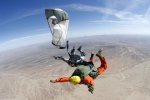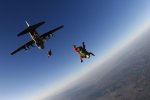Free courses online with qualifications
 FORT BRAGG, N.C. (Oct. 4, 2012) - In today's global environment, areas of conflict are becoming increasingly difficult for military forces to access. Through advances in technology, tactics and training, potential adversaries are prepared to prevent unwanted forces' physical presence, and the U.S. military must adapt to face these challenges.
FORT BRAGG, N.C. (Oct. 4, 2012) - In today's global environment, areas of conflict are becoming increasingly difficult for military forces to access. Through advances in technology, tactics and training, potential adversaries are prepared to prevent unwanted forces' physical presence, and the U.S. military must adapt to face these challenges.
A collective military free-fall, or MFF, capability throughout the Army's Special Forces regiment will ensure the U.S. Army's unconventional warfare force can effectively enter and perform within the operational areas of today and tomorrow.
Traditional forced-entry techniques such as low-altitude, static-line airborne operations have lost viability as a clandestine entry technique, especially in special-operations missions where silence and accuracy are crucial to mission success. Discreet, low-visibility free-fall infiltration complements the mission and structure of a Special Forces operational detachment-alpha, or ODA.
As a 12-man unit armed with the cultural and tactical expertise to work alongside a partner force, one ODA is small enough to maintain its MFF qualification, and use the capability to enter a remote area where a larger, conventional Army presence would not be feasible, necessary or cost-effective.
As written in the Department of Defense's Joint Operational Access Concept dated Jan. 17, 2012, "Operational access does not exist for its own sake, but rather serves our broader strategic goals. Joint forces must be able to project military force into any operational area … This is not a new challenge, but it is one that U.S. joint forces have not been called upon to face in recent decades. That condition is likely change, and may prove to be of critical importance in the coming years."
That condition is likely change, and may prove to be of critical importance in the coming years."
To meet this challenge, the Special Forces Regiment has re-evaluated its training methodology to ensure its Soldiers have an expansive skill set to meet the demands of our current and future operational environment. This reevaluation has established that while Army Special Forces units do include select MFF-capable ODAs, the force lacks a formal, wide-spread clandestine infiltration capability; such that would be available through regiment-wide military free-fall qualification.
To improve the U.S. Army Special Forces Command (Airborne) units' proficiency in MFF, the U.S. Army John F. Kennedy Special Warfare Center and School is prepared to incorporate military free-fall training into the Special Forces Qualification Course, or SFQC. This initiative will increase the regiment's collective forced-entry and global response capabilities.
This initiative will institutionalize MFF operations by investing in the Military Free-Fall School at Yuma Proving Ground in Yuma, Ariz., which is the U.S. Special Operations Command's proponent for military free fall.
The school is restructuring the Military Free Fall Parachutist Course, or MFFPC, so that it will offer sufficient annual training slots for all SFQC candidates while maintaining allocated slots for qualified Special Forces personnel already assigned to operational units. Beginning in February 2013, the MFFPC will transition from a four-week to a three-week course.
You might also like









